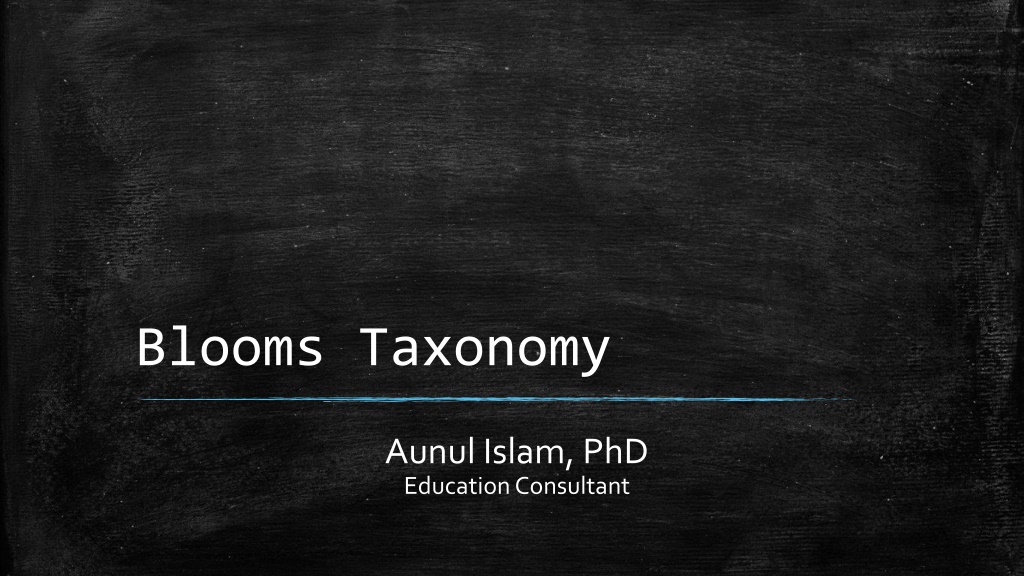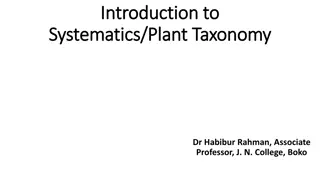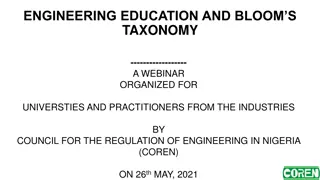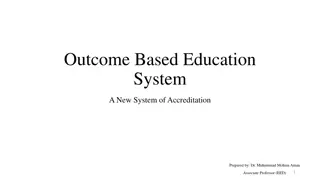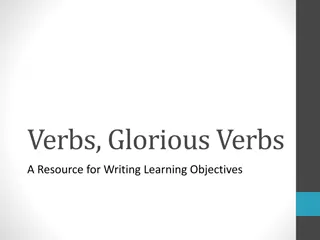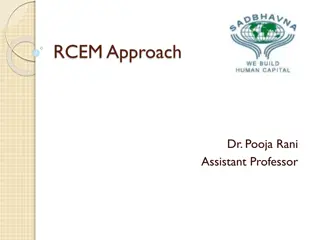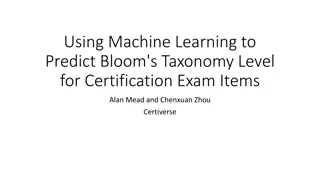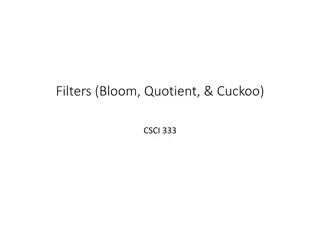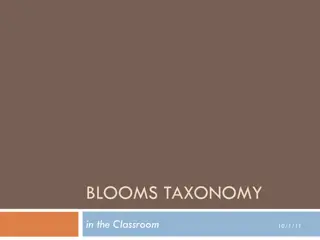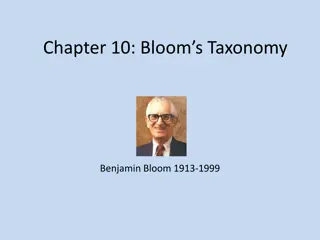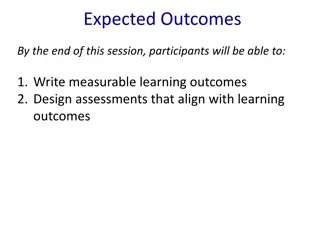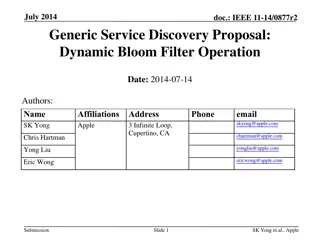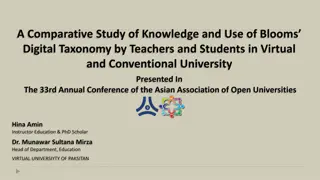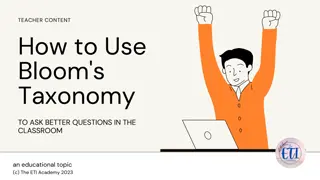Understanding Bloom's Taxonomy of Learning Domains
Bloom's Taxonomy, developed in 1956, focuses on promoting higher-order thinking in education. It categorizes learning into three domains: Cognitive (knowledge), Psychomotor (manual skills), and Affective (attitude). While Bloom's committee initially omitted the Psychomotor domain due to teaching limitations, other researchers have since created models for addressing manual skills. The taxonomy aims to enhance learning processes by emphasizing understanding, application, analysis, and evaluation of concepts rather than mere memorization of facts. By encompassing cognitive, psychomotor, and affective aspects, educators and trainers can effectively structure learning experiences to foster the acquisition of new knowledge, skills, and attitudes.
Download Presentation

Please find below an Image/Link to download the presentation.
The content on the website is provided AS IS for your information and personal use only. It may not be sold, licensed, or shared on other websites without obtaining consent from the author. Download presentation by click this link. If you encounter any issues during the download, it is possible that the publisher has removed the file from their server.
E N D
Presentation Transcript
Blooms Taxonomy Aunul Islam, PhD Education Consultant
Taxonomy It s a science and practice of classification The word finds its roots in the Greek Language Taxis meaning order , arrangement and Nomos law or science Taxonomy may refer to: Science, General, Business and Economics, Education
WHICH OF THESE *COGNITIVE SKILLS WILL BE USED BY A LEARNER WHEN BEING TAUGHT OR TRAINED: *Cognitive : conscious mental activities Percentage Importance Skill level Remember Recollect Recall Relive Understand Know Comprehend Deduce Apply Contest Analyse Study Examine Review Evaluate Consider Plan Contemplate Create Form Invent
Topics covered Blooms Taxonomy of Learning Domains Three Domains of Learning Blooms Revised Taxonomy
Introduction Bloom's Taxonomy was created in 1956 A research committee led by educational psychologist Dr Benjamin Bloom to promote higher forms of thinking in education analysing and evaluating concepts, processes, procedures and principles rather than just remembering facts (rote learning) most often used when designing educational, training, and learning processes
Three domains (categories) of learning Cognitive: mental skills or knowledge - (K) Psychomotor: Manual or physical skills - (S) Affective: Growth in feelings or emotional areas (attitude or self) - A Above referred to as KSA by educators, trainers and researchers
KSA These categories of behaviours may be considered as goals of learning That is, after a learning or training process/episodes a learner should have acquired new knowledge, skills and/0r attitude Bloom and his committee made extensive compilation of work related to Cognitive (Knowledge) and Affective (attitude) domains BUT omitted the Psychomotor (skills) due to limitation of teaching manual skills HOWEVER other researchers were able to create 3 models with respect to Psychomotor (manual skills )
Categories (Revised) within the Cognitive domain Remember Understand Apply Analyse Evaluate Create THE CATEGORIES CAN BE CONSIDERED AS DEGREES OF DIFFICULTIES. THAT IS FIRST ONE MUST BE MUSTERED BEFORE THE NEXT ONE CAN BE ACHIEVED.
Revised Bloomss Taxonomy 2. 1. Understan d Remember 3. 4. Apply Analyse 5. 6. Evaluate Create RevisedBloom s Taxonomy (Krathwohl, et al. 2000)
What do they mean? Remember exhibit memory of learning material through recall Understand demonstrate understanding of key facts and concepts Apply solve problems when faced with new situations Analyse examine and break down to generalise and make inferences Evaluate judge information to present and defend opinions Create put parts together to form a new / alternative whole
Why is this important to understand? These are the levels at which learning takes place. Allows instructions to learners and teaching strategies to be categorised. It also represents an evolution of learning maturity.
Revised Blooms Taxonomy Lorin Anderson, a former student of Bloom, along with co-researcher David Krathwohl revisited the cognitive domain in the midnineties. Some changes were made with perhaps the three most prominent ones being (Anderson, et al 2000): >> Changing the names from noun to verb in all the six categories >> Rearranging them ( as illustrated in the previous slide ) >>Creating processes and levels of knowledge matrix This new taxonomy reflects a more active form of thinking and is perhaps more accurate
Cognitive processes and levels of knowledge matrix (rubric) The below three levels added within each categories and adding another level of knowledge metacognition (intuition) acquainted with a discipline or solve problems. Conceptual The interrelationships among the basic elements within a larger structure that enable them to function together. Procedural How to do something, methods of inquiry, and criteria for using skills, algorithms, techniques, and methods. Factual The basic elements students must know to be
Matrix (Krathwohl and Anderson) Knowledge Dimension Remember Understand Apply Analyse Evaluate Create Factual Conceptual Procedural *Meta- cognitive
Further matrix (Clark et al 2004;Clark et al 2007) Knowledge Dimension Remember Understand Apply Analyse Evaluate Create Facts List Para- phrase classify outline rank categorise Concepts recall explain show contrast criticise modify Processes outline estimate produce diagram defend design Procedures reproduce Give an example relate identify critique plan Principles state converts solve differentiate conclude revise Meta- Cognitive Proper use interpret discover infer predict actualise
References Anderson, L.W., Krathwohl, D.R., Airasian, P.W.,Cruikshank, K.A., Mayer, R.E., Pintrich, P.R., Raths, J.,Wittrock, M.C. (2001).A Taxonomy for Learning, Teaching, and Assessing: A revision of Bloom's Taxonomy of Educational Objectives. New York: Pearson, Allyn & Bacon. Bloom, B.S. (Ed.). Engelhart, M.D., Furst, E.J., Hill, W.H.,Krathwohl, D.R. (1956).Taxonomy of Educational Objectives, Handbook I: The Cognitive Domain. New York:David McKay Co Inc. Clark, R., Chopeta, L. (2004). Graphics for Learning :Proven Guidelines for Planning, Designing, and Evaluating Visuals in Training Materials . San Francisco: JosseyBass/Pfeiffer.
Pavitts Taxonomy! Why don t you all have a read on this!
